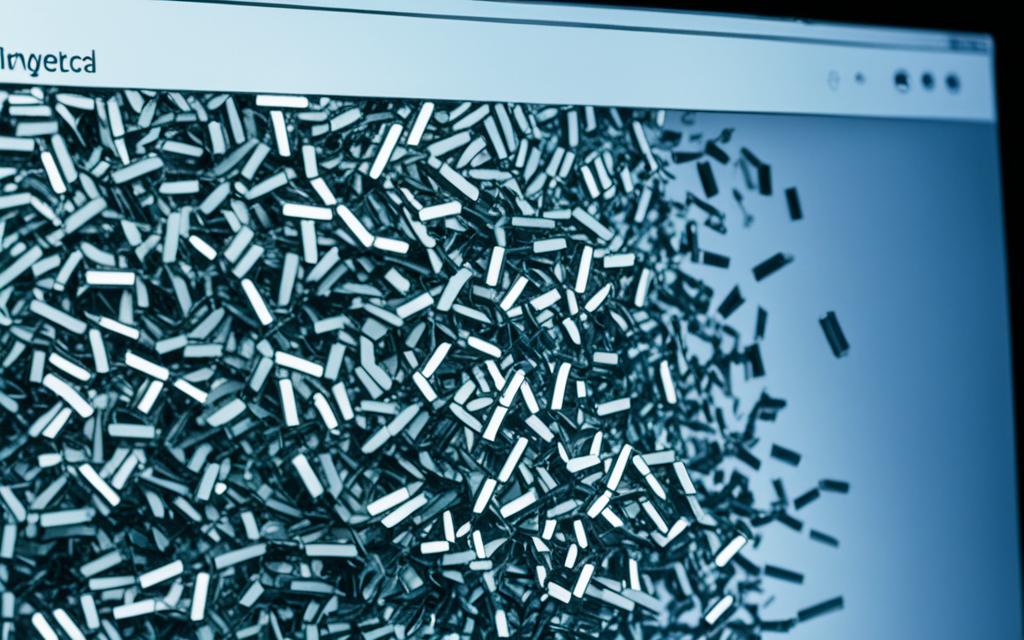Table of Contents
Understanding how to truly erase files from a hard drive is crucial for data security. Many people don’t know that simply moving files to the recycle bin doesn’t actually remove them permanently. In fact, around 80% of computer users are not aware that deleted files can still be recovered from a hard drive1. This is a big issue for keeping sensitive info safe, as files deleted the normal way can be gotten back with the right tools.
For true deletion, looking into secure methods is key. Using data wiping software ensures files are gone for good, boosting your peace of mind and your system’s efficiency. For example, files erased with the “clean all” command are nearly impossible to bring back2. Understanding how data deletion works helps in both making space on your hard drive and protecting your online identity.
This article shows you how to really remove files forever, no matter the operating system. Knowing how to do this safely protects your important data. Whether you’re trying to delete files for good or just want to clear up space, these steps will improve how you handle your digital life. For step-by-step instructions on safe file deletion, visit AVG’s official site.
Key Takeaways
- Understanding the risks of conventional file deletion is vital for data security.
- Specialised software tools provide reliable methods for permanently removing files.
- Files deleted using secure commands are much harder to recover.
- Avoid quick formatting to ensure data cannot be easily retrieved.
- Utilising tools such as Eraser can enhance your approach to data protection.
Understanding the Need for Permanent File Deletion
Knowing how file deletion works is crucial. When you delete a file, it doesn’t vanish instantly. It might stay on your hard drive, creating risks. This issue affects not just personal privacy but also the security of sensitive info. It’s key to understand this in today’s world where keeping data safe is a top priority.
What Happens When You Delete Files
Deleting a file first moves it to the Recycle Bin. But, just emptying the Bin doesn’t really remove the data. Surprisingly, only 1 in 10 people know that deleting a file on Windows doesn’t wipe it from the hard drive3. The deleted files can often be brought back; special software can get them back in most cases. These files remain retrievable until new data overwrites them, showing why better deletion methods are needed.
Implications for Data Security
It’s vital to delete files for good to protect sensitive and personal info. Many people don’t know how file deletion works. For instance, most think that emptying the Recycle Bin fully deletes files3. This misunderstanding poses a risk, as hackers look to exploit such gaps in knowledge. Data shows that nearly everyone sees the value in deleting files permanently to prevent unauthorized access and keep their privacy safe3.
Methods to Permanently Delete Files
Today, it’s crucial to know how to delete files for good in our digital world. To make sure private information is gone forever, we must use effective data wiping methods. There are many ways to securely delete files. The method you choose should match what you have and know how to use.
Using Data Wiping Software
One top method is using strong data wiping software, like DiskGenius Free Edition. This software writes over the parts of your hard drive where deleted files were. This makes it almost impossible to get the files back4. You can pick how to overwrite files, with zeros or random stuff, to ensure they can’t be found5. Features that let you clear whole disks or just free space boost security. They help you clean your data properly4. For people who know more, using command-line tools can make the process even better. This method deletes files securely without sending them to the Recycle Bin5.
Keyboard Shortcuts and Manual Deletion
Want a faster way? Keyboard shortcuts like Shift + Delete can skip the Recycle Bin and delete files right away5. This method is quick but be careful. The files could be retrieved until their space is written over again4. The Recycle Bin is okay for keeping files temporarily, but not for those that are confidential. To really enhance security, try deleting files manually. Use options in the right-click menu within File Explorer. Yet, for the best security, combine these methods with data wiping software. This greatly lowers the chance of someone recovering your files6.
How to Remove Files Permanently from Hard Drive
Removing sensitive information from your hard drive for good requires special steps. Wiping software is key in this. Different tools, with various features, suit many needs. They help in wiping files and free space to fight data leftovers effectively.
Wiping Files with Software Tools
For secure deletion, many turn to tools like AOMEI Partition Assistant Standard. About 80% of its users rate it highly for erasing files forever7. This tool has a simple layout. It makes choosing and confirming files to delete easy. And 93% of users say it’s easy to use, especially its “Wipe Hard Drive” option7.
Wiping Free Space and Data Remanence
Clearing hard drive’s free space after deletion stops old data from staying. Even if files are marked as deleted, some parts can still pose a risk. Using tools to overwrite spaces where files were keeps your data safe.
The “Fill sectors with zero” option in AOMEI is popular for its efficiency8. Using the Cipher command in Windows also ensures thorough overwriting, keeping files secure against any future recovery efforts9.
| Method | Description | Effectiveness |
|---|---|---|
| AOMEI Partition Assistant Standard | Permanently deletes files using user-friendly features. | 80% of users prefer it; 93% find it easy to use. |
| Cipher Command | Overwrites files to ensure secure deletion on Windows. | Offers high level of security through overwriting. |
| Zero Fill Method | Fills sectors with zeroes to remove previous data. | Commonly used; helps mitigate recovery risks. |
Considerations for Different Drive Types
Different drives like HDDs and SSDs work in unique ways, making data deletion needs vary. Each type demands specific methods to ensure deleted data can’t be brought back. Tailored approaches help ensure that HDD and SSD data deletion is effective.
Deleting Files from a Hard Disk Drive (HDD)
Deleting files from an HDD doesn’t remove them straight away. It just marks the spot as free. The data stays until new data covers it, possessing a risk of data theft. Secure deletion tools are crucial for completely erasing sensitive info from these drives. EaseUS Data Recovery Wizard is an example of software that ensures important data is securely managed10.
Permanently Deleting Files from Solid State Drives (SSD)
SSDs remove files differently than HDDs, usually erasing data right away. But, some data might stick around unless special wiping tools are used. SSDs have features like TRIM to avoid holding onto deleted data, making SSD deletion smoother. Using the right tools is key for wiping SSDs effectively11
| Aspect | HDDs | SSDs |
|---|---|---|
| Data Deletion Mechanism | Marks space as available | Immediate erasure |
| Risk of Data Recovery | High until overwritten | Low, but residual data possible |
| Secure Deletion Tools | Required for thorough removal | File and free space wiping tools needed |
| Built-in Features | Usually none | TRIM to prevent remnants |
As data management changes, knowing the differences between HDDs and SSDs is crucial. It ensures data deletion is both effective and secure11.
Conclusion
Secure file deletion is vital for keeping our personal data safe. This article showed how necessary effective deletion methods are. Simply deleting files doesn’t fully erase them. They can still be recovered12. Instead, using tools like BitRaser File Eraser or CubexSoft Data Wipe Tool helps. They overwrite files so no one can get them back, keeping your data safe from theft1312.
Deleting files securely depends on the type of drive you have. For example, external hard drives need special care to remove data for good13. It’s vital to prevent unwanted access and keep data safe, especially nowadays when data leaks happen a lot. Following these safety methods is key for anyone who wants to protect their information.
Using secure file deletion methods is crucial in our digital age. It’s not just for convenience but a serious duty. Doing so gives you confidence that your personal and professional life is safe. Especially when you’re getting ready to reset your systems, it’s an extra step for ensuring security14.
FAQ
What is the difference between deleting a file and permanently deleting it?
When you delete a file normally, it goes to the Recycle Bin. There, it can be recovered. Permanently deleting a file involves secure methods. This makes sure the data can’t be got back, keeping your info safe from being retrieved.
Can files recovered from the Recycle Bin be permanently deleted?
Yes, you can still permanently get rid of files once removed from the Recycle Bin. They can be recovered unless securely wiped from the drive. For the best protection, using data wiping software is key for total removal.
Is it possible to securely delete files manually without software?
Using Shift + Delete removes files but doesn’t stop potential recovery until the space is used again. Opting for dedicated software is best for certain deletion.
What are the benefits of using data wiping software?
Tools like BCWipe or AVG’s Data Shredder overwrite where deleted files were. This makes recovering them really tough. These tools give you peace of mind about keeping your data safe.
How can I wipe free space on my hard drive?
After removing files, it’s crucial to overwrite the free space. Doing so makes sure that areas that had deleted files are securely wiped. This stops anyone from accessing old files.
What should I consider when permanently deleting files from an HDD?
Deleting files from an HDD marks the space as free but doesn’t erase it right away. Using secure deletion tools is necessary for fully cleaning away the leftover data.
How does deleting files differ on a Solid State Drive (SSD)?
SSDs immediately erase files, making them unrecoverable. But, bits of data can remain. Using file wiping, free space wiping tools, and features like TRIM helps clear these leftovers.
Source Links
- https://www.pcworld.com/article/504414/how_do_i_permanently_delete_files_from_my_hard_disk.html – How Do I Permanently Delete Files From My Hard Disk?
- https://www.minitool.com/news/how-to-permanently-delete-files-from-external-hard-drive.html – Guide: How to Permanently Delete Files From External Hard Drive
- https://www.easyfileshredder.com/how-to-permanently-delete-files-on-windows.php – Easy File Shredder – Securely Delete Files from Windows PC
- https://www.diskgenius.com/resource/permanently-delete-files.html – How to Permanently Delete Files from Computer Hard Drives in Windows 10/11?
- https://softkeys.uk/blogs/blog/how-to-permanently-delete-files-from-hard-drive-windows-10 – How to Permanently Delete Files From Hard Drive Windows 10?
- https://www.popsci.com/permanently-delete-files/ – Permanently delete files (for real)
- https://www.diskpart.com/windows-10/permanently-delete-files-from-hard-drive.html – How to Permanently Delete Files from Hard Drive on Windows 10, 8, 7?
- https://www.titanfile.com/blog/how-to-securely-delete-files-on-your-computer/ – How to Securely Delete Files on Your Computer – TitanFile
- https://recoverit.wondershare.com/erase-data/how-to-permanently-delete-files-from-windows.html – How to Permanently Delete Files on Windows Computer
- https://www.easeus.com/storage-media-recovery/permanently-delete-files-hard-drive.html – How to Permanently Delete Files from Hard Drive [Windows 11]
- https://www.stellarinfo.com/blog/how-do-i-permanently-delete-files-from-my-external-hard-drive/ – How to Permanently Delete Files from External Hard drive?
- https://www.stellarinfo.co.in/blog/how-to-permanently-delete-files-from-hard-drive/ – [Solution]: How to Permanently Delete Files from Hard Drive?
- https://www.cubexsoft.com/blog/permanently-delete-files-from-external-hard-drive/ – How to Permanently Delete Files from External Hard Drive
- https://www.anyrecover.com/deleted-files-recovery-data/permanently-delete-files-windows/ – How to Permanently Delete Files on PC Without Recovery? 【Works with all Windows】








